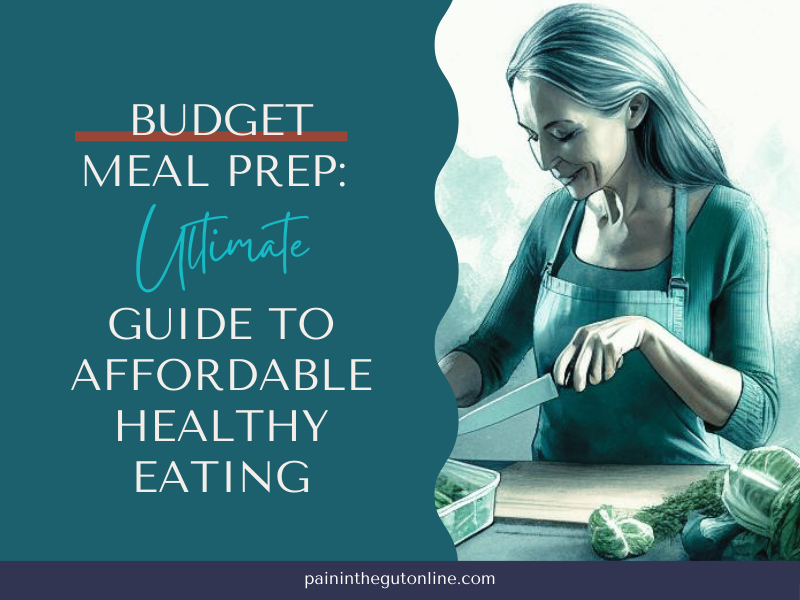AFFORDABLE HEALTHY EATING
13 min/2,952 words
Master healthy budget meal prep like a pro! Discover affordable healthy eating and conquer your kitchen on a budget.

Table of Contents
Getting Started with Affordable Healthy Eating Meal Prep
Budget meal prep is the way to go if you’re looking to save money while still enjoying delicious and nutritious meals. By planning and preparing your meals in advance, you can stick to your budget, save time, and make healthier choices.
Let’s explore the benefits of affordable healthy eating and how to set up your kitchen for a successful meal prep session.
Benefits of Budget Meal Prep

Budget meal prep offers numerous advantages that go beyond just saving money.
By investing a little time and effort upfront, you can reap the following benefits:
- Saves Money: By planning your meals and buying ingredients in bulk, you can take advantage of discounts and avoid impulse purchases. This can significantly reduce your overall grocery bill.
- Saves Time: With pre-prepared meals, you can say goodbye to last-minute cooking and decision-making. By dedicating a few hours each week to meal prep, you can have ready-to-eat meals throughout the week, saving you precious time.
- Promotes Healthier Eating: When you have healthy meals readily available, you’re less likely to resort to unhealthy takeout or processed foods. Budget meal prep allows you to control the ingredients and portion sizes, helping you make healthier choices.
- Reduces Food Waste: By planning your meals in advance, you can utilize ingredients more efficiently and reduce food waste. You’ll also have leftovers that can be repurposed into new meals, minimizing food waste even further.
Setting Up Your Kitchen for Success

To get started with budget meal prep, it’s important to have a well-equipped kitchen that supports your efforts.
Here are some key considerations:
- Meal Prep Containers: Invest in a set of reusable, microwave-safe containers in various sizes. These containers will be your best friends when it comes to portioning and storing your meals. Look for BPA-free options that are durable and easy to clean.
- Food Storage: Stock up on quality food storage options such as glass jars, resealable bags, and airtight containers. These will come in handy for storing ingredients, leftovers, and prepped ingredients.
- Basic Kitchen Tools: Ensure you have essential kitchen tools like sharp knives, cutting boards, measuring cups and spoons, mixing bowls, and cookware. Having these tools readily available will make your meal prep process efficient and enjoyable.
- Pantry Staples: Keep your pantry stocked with budget-friendly staples like rice, pasta, beans, canned vegetables, and spices. These versatile ingredients form the foundation for many budget-friendly meals.
- Meal Planning Resources: Utilize meal planning resources such as cookbooks, online recipe sources, and meal planning apps. These tools can provide inspiration, help you discover new recipes, and simplify the meal planning process.
By understanding the benefits of budget meal prep and setting up your kitchen with the necessary tools and resources, you’re well on your way to enjoying delicious and affordable meals.
In the next section, we’ll dive into meal planning tips and creating a grocery list to maximize your budget.
Planning Your Budget-Friendly Meals

When it comes to an affordable healthy eating meal prep session, effective planning is key to ensuring that you have delicious and affordable meals throughout the week.
This section will explore some meal-planning tips and guide you on creating a grocery list that fits your budget.
Meal Planning Tips
Meal planning is a fantastic way to save time and money and ensure you have readily available healthy, nutritious meals.
Here are some tips to help you get started:
- Set a Weekly Meal Plan: Take some time at the start of each week to plan your meals. Consider your schedule, dietary preferences, and the ingredients you already have in your pantry. This helps you avoid last-minute unhealthy food choices and reduces food waste.
- Explore Budget-Friendly Recipes: Look for recipes that use affordable ingredients and are easy to prepare. Websites, cookbooks, and online resources often have a wide variety of budget-friendly healthy meals to choose from. Check out our article on budget-friendly healthy meals for inspiration.
- Utilize Leftovers: Incorporate leftovers into your meal plan. For example, if you roast a chicken for dinner one night, plan to use the leftover meat for sandwiches or salads the next day. This minimizes food waste and stretches your budget further.
- Consider Batch Cooking: Prepare larger quantities of certain meals that can be divided and stored for future use. This can be particularly helpful when you have a busy schedule and limited time for cooking. Batch cooking allows you to have ready-to-eat meals throughout the week without the need for excessive cooking time.
Creating a Grocery List
Creating a well-thought-out grocery list is essential to ensure that you have all the ingredients you need for your budget-friendly meals. Here are some steps to help you create an effective grocery list:
- Take Inventory: Before heading to the grocery store, check your pantry, refrigerator, and freezer to see what ingredients you already have on hand. This prevents unnecessary duplicate purchases and helps you make the most of what you already have.
- Plan According to Sales: Keep an eye on weekly sales flyers or online deals to identify any discounted items. Incorporate these sale items into your meal plan and grocery list to take advantage of the cost savings. Our article on grocery shopping on a budget provides additional tips for finding the best deals.
- Stick to the List: Once you have your meal plan and inventory in mind, write down the specific ingredients you need for each recipe. Organize your list by sections (e.g., produce, dairy, pantry) to make your shopping trip more efficient. Stick to your list and avoid impulse purchases to stay within your budget.
- Consider Seasonal Produce: Seasonal fruits and vegetables are often more affordable and at their peak flavor. Incorporate in-season produce into your meal plan to save money and enjoy the freshest ingredients. Our article on eating healthy on a budget provides further guidance on this topic.
By following these meal planning tips and creating a well-organized grocery list, you’ll be well-prepared to tackle budget meal prep. Remember to be flexible and adjust your meal plan based on your budget and available ingredients.
With a little creativity and planning, you can enjoy delicious, nutritious meals without breaking the bank.
Budget-Friendly Ingredients

When it comes to budget meal prep, one of the key factors is selecting affordable ingredients that still provide great flavor and nutrition.
By stocking up on budget-friendly staples and making the most of in-season produce, you can create delicious and cost-effective meals.
Affordable Staples to Stock Up On
Building a pantry stocked with affordable staples is essential for budget meal prep. These versatile ingredients can be used in a variety of recipes and provide a solid foundation for your meals.
Here are some budget-friendly staples to consider:
| Staple | Price Range |
|---|---|
| Rice | $1 – $2 per pound |
| Pasta | $1 – $2 per pound |
| Canned Beans | $0.50 – $1 per can |
| Lentils | $1 – $2 per pound |
| Oats | $2 – $3 per pound |
| Canned Tomatoes | $1 – $2 per can |
| Peanut Butter | $2 – $4 per jar |
| Frozen Vegetables | $1 – $2 per bag |
| Eggs | $2 – $4 per dozen |
| Chicken Thighs | $1 – $2 per pound |
| Ground Beef | $3 – $5 per pound |
By having these staples readily available in your kitchen, you can create a variety of budget-friendly meals without breaking the bank.
Making the Most of In-Season Produce
In-season produce not only tends to be more affordable but also offers optimal flavor and nutritional value. By incorporating in-season fruits and vegetables into your meal prep, you can enjoy delicious and cost-effective meals.
Here are some examples of in-season produce and their approximate price range:
| In-Season Produce | Price Range |
|---|---|
| Apples | $1 – $2 per pound |
| Oranges | $0.50 – $1 per piece |
| Spinach | $2 – $3 per bunch |
| Carrots | $1 – $2 per pound |
| Zucchini | $1 – $2 per pound |
| Bell Peppers | $1 – $2 per piece |
| Tomatoes | $1 – $2 per pound |
| Cabbage | $1 – $2 per head |
| Sweet Potatoes | $1 – $2 per pound |
| Squash | $1 – $2 per pound |
By selecting in-season produce, you not only save money but also enjoy the freshest and most flavorful ingredients. Incorporate these ingredients into your budget-friendly meals for added variety and nutritional benefits.
With these affordable healthy eating staples and in-season produce, you can create delicious and nutritious meals without breaking the bank.
Meal Prep Techniques

Incorporating meal prep techniques into your routine can be a game-changer to make budget-friendly eating even more efficient and convenient.
Two key techniques that can help you save time and money are batch cooking and proper portioning and storage of meals.
1. Batch Cooking for Efficiency
Batch cooking involves preparing larger quantities of food at once to have ready-made meals for future consumption. This technique saves you time and allows you to take advantage of bulk discounts when purchasing ingredients.
Here’s how you can make batch cooking work for you:
- Choose recipes that lend themselves well to batch cooking: Look for recipes that can be easily scaled up, such as soups, stews, casseroles, and stir-fries. These dishes often benefit from flavors melding together over time, making them even tastier when reheated.
- Plan your meals and ingredients: Decide the meals you want to make for the week and create a meal plan. This will help you determine the quantity of ingredients you need and ensure that you’re utilizing all the ingredients efficiently.
- Cook in bulk: Prepare a larger batch of your chosen recipe, keeping in mind the number of servings you’ll need for the week. Invest in larger pots, pans, and baking sheets to accommodate larger quantities. Consider using slow cookers or pressure cookers for easy and hands-off cooking.
- Portion and store: Once the food is cooked, divide it into portions using reusable and microwave-safe containers. Label each container with the contents and date to help with organization. Store the containers in the refrigerator or freezer, depending on when you plan to consume them.
Batch cooking allows you to have ready-made meals on hand, reducing the need for last-minute takeout or expensive convenience foods.
With a little planning and preparation, you can save both time and money while enjoying delicious, homemade meals.
2. Portioning and Storing Meals
Proper portioning and storage are essential for maintaining the quality and freshness of your prepared meals.
Here are some tips to help you portion and store your meals effectively:
- Use portion control guidelines: Determine the appropriate portion size for each meal based on your nutritional needs. Portion control is key to preventing overeating and ensuring that your meals stretch further. You can find portion size recommendations in our article on budget-friendly meals.
- Invest in quality storage containers: Use airtight containers that are microwave-safe, freezer-friendly, and durable. Glass or BPA-free plastic containers are excellent options. Consider reusable silicone bags or wraps for items like sandwiches or snacks.
- Divide and conquer: Divide your batch-cooked meals into individual portions and transfer them into the appropriate containers. This not only helps with portion control but also makes it easier to grab a meal when you’re on the go or short on time.
- Label and organize: Label each container with the contents and date to keep track of the meals in your fridge or freezer. Organize your storage space to ensure easy access to different meals throughout the week.
- Freeze for later: If you’re not planning to consume all the meals within a few days, freeze them for longer-term storage. Freezing helps maintain the quality of the food and extends its shelf life. Refer to our article on cooking on a budget for freezing and thawing tips.
Properly portioning and storing your prepared meals allows you to have a variety of options readily available, reducing food waste and saving money.
By following these techniques, you can make the most of your budget and enjoy delicious, homemade meals without the stress of daily cooking.
Flavorful and Affordable Recipes

When it comes to budget meal prep, there’s no need to sacrifice flavor or variety. With a little creativity and planning, you can enjoy delicious and affordable meals throughout the day.
Here are some ideas for budget-friendly recipes that will keep your taste buds satisfied without breaking the bank.
Breakfast Ideas
Start your day off right with these tasty and budget-friendly breakfast options:
- Oatmeal with Toppings: A bowl of oatmeal is not only filling but also budget-friendly. Customize your oatmeal with toppings like fresh fruits, nuts, or a drizzle of honey. Oats are a great source of fiber and can help keep you full until lunchtime.
- Egg Muffins: Whip up a batch of egg muffins by whisking together eggs, your favorite vegetables, and some shredded cheese. Bake them in a muffin tin for a convenient grab-and-go breakfast option.
Lunch and Dinner Options
For satisfying and affordable lunches and dinners, try these recipes:
- Vegetable Stir-Fry: Stir-fries are a fantastic way to make the most of affordable vegetables. Choose a variety of colorful vegetables like bell peppers, broccoli, carrots, and snap peas. Add some protein like tofu or chicken, and season with soy sauce or your favorite stir-fry sauce. Serve over a bed of rice or noodles.
- Bean and Vegetable Soup: Soups are not only comforting but also an economical choice. Create a hearty and nutritious bean and vegetable soup by combining canned beans, diced tomatoes, onions, carrots, and celery. Season with herbs and spices for added flavor. Enjoy with a side of whole-grain bread.
Snacks and Desserts
Don’t forget about budget-friendly snacks and desserts to satisfy your cravings:
- Homemade Trail Mix: Create your own trail mix by combining assorted nuts, dried fruits, and whole-grain cereal. This nutritious snack is not only budget-friendly but also portable, making it perfect for on-the-go munching.
- Frozen Banana Bites: Slice a banana into bite-sized pieces and dip them in melted dark chocolate. Place them on a baking sheet lined with parchment paper and freeze until firm. These frozen banana bites make for a satisfying and healthier dessert option.
Remember to be creative and adjust based on your preferences and dietary needs.
Planning and preparing your meals in advance allows you to enjoy delicious and budget-friendly recipes throughout the day.
Staying Motivated and Consistent

To make budget meal prep a sustainable lifestyle choice, it’s important to stay motivated and consistent with your efforts.
Here are some tips to help you track your progress and achieve long-term success.
Tracking Your Progress
Tracking your progress is a powerful tool for staying motivated and accountable. Here are a few ways you can track your budget meal prep journey:
- Keep a Food Diary: Maintain a journal or use a food tracking app to record your meals, snacks, and grocery expenses. This will help you stay mindful of your eating habits and identify areas for improvement.
- Monitor Your Spending: Track your grocery spending each week to ensure you are staying within your budget. This will help you identify any areas where you may be overspending and make necessary adjustments.
- Measure Your Savings: Compare your current grocery spending with your previous spending before starting budget meal prep. Calculate the amount of money you save each week or month. Seeing the tangible savings can be a great motivator to stick with your budget meal prep routine.
- Take Before and After Photos: Take photos of your meals or yourself before you start budget meal prep, and continue to take progress photos along the way. Seeing the transformation and the delicious meals you create can boost your motivation.
Tips for Long-Term Success
Achieving long-term success with budget meal prep requires dedication and a positive mindset.
Here are some tips to help you stay on track:
- Stay Organized: Continue to use meal planning and grocery lists to stay organized and efficient. This will help you avoid impulse purchases and ensure that you have everything you need for your budget-friendly meals.
- Variety is Key: Keep your meals interesting and avoid getting bored by incorporating a variety of flavors, ingredients, and cuisines into your meal prep. Experiment with new recipes and try different combinations of ingredients to keep your taste buds excited.
- Embrace Leftovers: Don’t let leftovers go to waste. Get creative and repurpose them into new meals or use them for lunch the next day. This will help you save money and reduce food waste.
- Find Support and Inspiration: Join online communities or forums where you can connect with others who are also on a budget meal prep journey. Share tips, recipes, and success stories to stay motivated and inspired.
- Reward Yourself: Celebrate your achievements along the way. Treat yourself to something you enjoy as a reward for sticking to your budget meal prep plan. It could be a new kitchen gadget or a special meal at a restaurant once in a while.
Remember, affordable healthy eating by meal prepping is not just about saving money; it’s also about nourishing your body with healthy and delicious meals. Stay focused on your goals, track your progress, and make adjustments as needed.
Want more?
Keep reading to find out even more about affordable healthy eating…
Grab our FREE No-Cook Recipes for Gut Health!
This is a no-strings-attached offer, seriously. All you need to do is click through to check out five completely free recipes for gut health.
After you grab those, if you still want more, consider joining our email list to receive five additional recipes for free.
Hope to see you on the other side!








